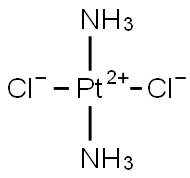15663-27-1

Product Name:
Cisplatin
Formula:
Cl2H6N2Pt
Synonyms:
Cisplatin;cis-Platinum (65% Pt);CPDC, DDP, cis-Diaminedichloroplatinum;cis-Diammineplatinum(II) dichloride;cis-Dichlorodiammine platinum(II)
Inquiry
SAFETY INFORMATION
| Signal word | Danger |
|---|---|
| Pictogram(s) |
 Skull and Crossbones Acute Toxicity GHS06  Health Hazard GHS08 |
| GHS Hazard Statements |
H300:Acute toxicity,oral H315:Skin corrosion/irritation H317:Sensitisation, Skin H319:Serious eye damage/eye irritation H334:Sensitisation, respiratory H335:Specific target organ toxicity, single exposure;Respiratory tract irritation H350:Carcinogenicity |
| Precautionary Statement Codes |
P201:Obtain special instructions before use. P280:Wear protective gloves/protective clothing/eye protection/face protection. P301+P310:IF SWALLOWED: Immediately call a POISON CENTER or doctor/physician. P302+P352:IF ON SKIN: wash with plenty of soap and water. P305+P351+P338:IF IN EYES: Rinse cautiously with water for several minutes. Remove contact lenses, if present and easy to do. Continuerinsing. |
PRODUCT INTRODUCTION
Description
Cisplatin was first identified in 1845; it was originally of interest during the development of coordination theory. At that time, it was called Peyrone’s salt or Peyrone’s chloride, after its discoverer, Michel Peyrone. In the mid-1960s, Cisplatin’s antitumor activity was demonstrated, and it has served as the gold standard (should that be “platinum standard”) against which newer drugs are compared. Cisplatin is probably best known for its role in helping Tour de France winner Lance Armstrong fight testicular cancer. The trans isomer does not exhibit a similar pharmacological effect.
Related Article: "Sound Science", Chemical & Engineering News, April 7, 2014
